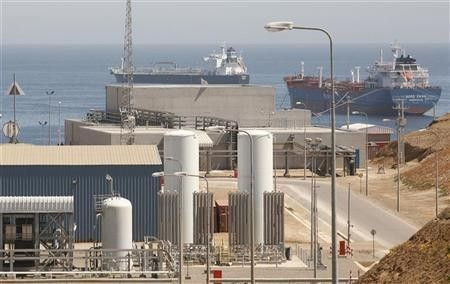Exporting Natural Gas Isn’t Easy For U.S. Infrastructure, Despite Ukraine Woes

Exporting natural gas and other forms of energy from the U.S. to foreign markets, a tantalizing long-term scenario bolstered by a U.S. shale oil and gas boom, won’t be easy.
The U.S. must still improve transportation and logistics infrastructure, which can move natural gas from productive inner regions of the country, like North Dakota, to coasts in preparation for exports. The earliest production for a U.S. liquefied natural gas (LNG) export terminal is late 2015, while exports could begin at the second Freeport LNG Development terminal in 2018.
That infrastructure gap means talk by Western officials about exporting natural gas to Ukraine to lessen its dependence on Russia remains a far-fetched scenario for now. Other options vetted by U.S. and EU governments include lessening Europe’s dependence on Russian oil and gas as a whole.
“Everybody is talking about this fracking technology and the North American energy revolution. Well, what does the North American energy revolution mean?” said S&P vice president for commodities indices Jodie Gunzberg to IBTimes in a February interview.
“It depends on the transportation and logistics infrastructure in place, and the deals that can make U.S. natural gas into a global commodity, deals which haven’t happened yet,” she said.
Gunzberg pointed out that natural gas is the only commodity in the benchmark GSCI commodity index based on North American markets only, rather than global production and price data.
That contrasts with international heavyweights like Brent crude oil, an easily transportable resource that determines prices for two-thirds of the world’s crude oil trade. Originally traded in London, it has since become a product on the Intercontinental Exchange.
It could be the end of this decade before liquefied natural gas exports ramp up significantly in other countries, like major energy producer Canada, Barclays PLC noted in a December report. The U.S. already exports some natural gas via pipelines to Canada and Mexico, though it has been a net importer of gas for years.
The U.S. has grown natural gas production from about 1.75 trillion cubic feet in 2010 to a forecast 2 trillion cubic feet for 2014, government data show. That boom has been helped by technologies like hydraulic fracturing, or "fracking," which have unlocked huge amounts of shale gas despite criticism from environmental activists.
Political opposition to fracking techniques may hinder U.S. natural gas exports more than underdeveloped infrastructure, according to University of Houston petroleum engineering professor John Lee.
There are few government approvals for exports so far, with few applications and actual permits. There have been six liquefied natural gas export terminals approved so far.
“Not many licenses, not nearly enough have been approved,” he told IBTimes. “Until the permits are obtained, the amount of gas is going to be limited.”
“The U.S. has much of the infrastructure that would be required to export natural gas,” he continued. Unmerited political opposition may be the real threat, according to Lee.
“I don’t think there are any significant risks related to hydraulic fracturing,” he added. “There hasn’t been a single case documented that hydraulic fracturing has harmed any water source, and several top government officials know this.”
-- Meagan Clark contributed to this article
© Copyright IBTimes 2024. All rights reserved.





















